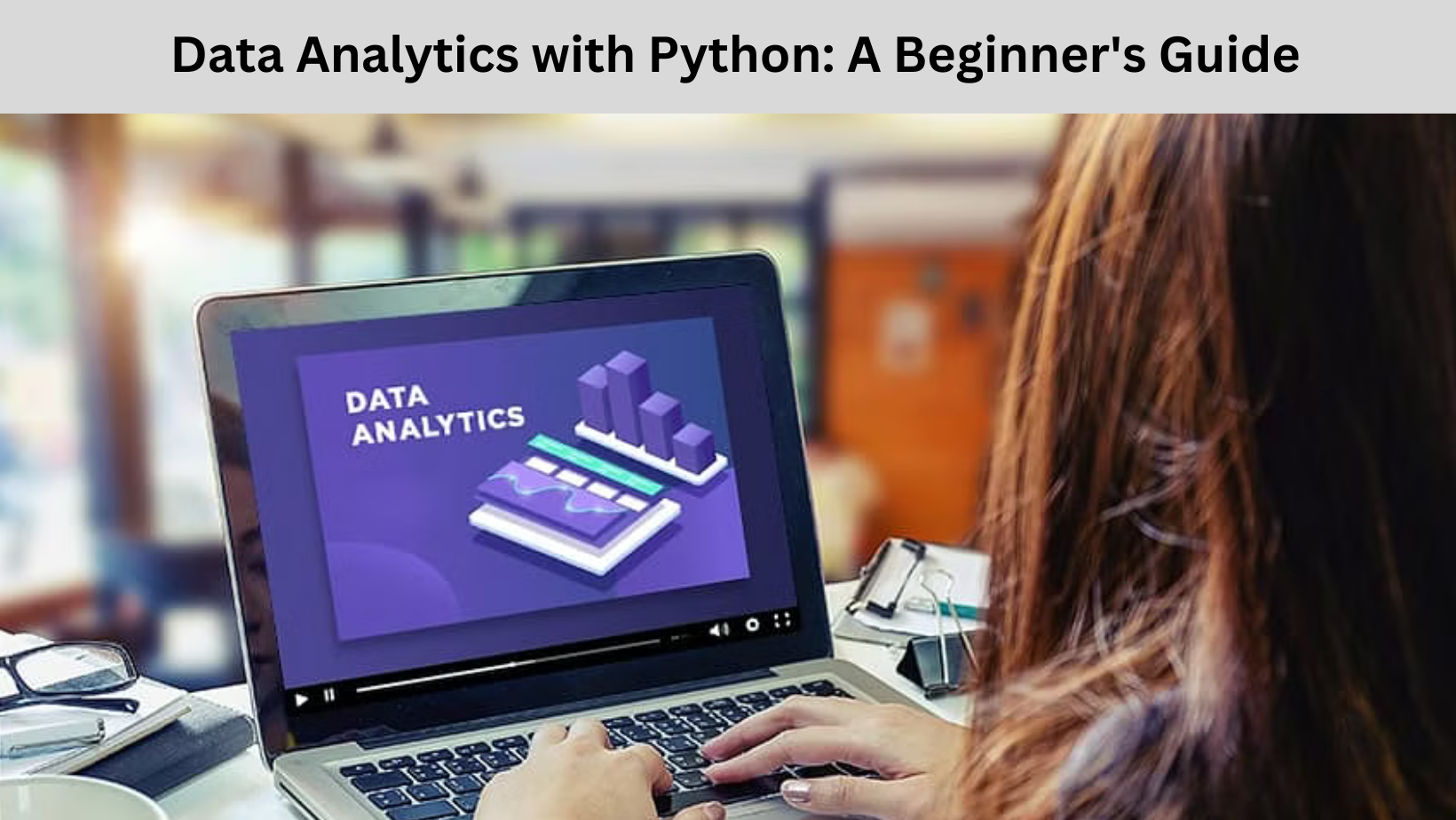Data Analytics with Python: A Beginner’s Guide
Data analytics is all about transforming raw data into meaningful insights. In an age where data drives decision-making, businesses and individuals turn to data analytics to uncover trends, patterns, and insights that can lead to smarter choices. Python, a versatile and beginner-friendly programming language, has become a top choice for data analytics due to its simplicity and wide range of powerful tools. In this guide, we’ll walk you through the essentials of using Python for data analytics, providing a clear and beginner-friendly path to get started.
Why Python for Data Analytics?
Python’s popularity in the field of data analytics is due to several compelling reasons:
- Beginner-Friendly: Python’s syntax is clear and readable, making it accessible for beginners. With a basic understanding of the language, even newcomers can quickly dive into data analysis.
- Powerful Libraries: Python offers a wide range of specialized libraries like Pandas for data manipulation, NumPy for mathematical operations, Matplotlib and Seaborn for visualization, and Scikit-Learn for machine learning. These libraries are designed to handle complex data analysis tasks effortlessly.
- Active Community and Resources: Python has a strong, supportive community, which means abundant resources, tutorials, and documentation are available to help with troubleshooting or learning new methods.
- Integration: Python integrates well with other tools and frameworks, making it suitable for data processing from various sources, such as databases, spreadsheets, or APIs.
Getting Started with Data Analytics Using Python
If you’re a beginner, setting up Python and getting familiar with the core libraries is essential for a smooth start in data analytics. Here’s a step-by-step guide.
Step 1: Set Up Your Environment
Before analyzing data, it’s necessary to set up a Python environment. While Python can be downloaded from its official website, using an integrated package like Anaconda is ideal for data analysis. Anaconda bundles Python with various essential libraries and provides access to Jupyter Notebook, an interactive platform that makes analyzing data more straightforward.
- Install Anaconda: This package includes Python and the libraries you’ll frequently use, simplifying the setup process.
- Launch Jupyter Notebook: Anaconda includes Jupyter Notebook, which allows you to write and test code in small, manageable sections, making it an excellent tool for data analysis and visualization.
Step 2: Familiarize Yourself with Key Libraries
In data analytics, a few essential libraries will become your primary tools. Let’s look at some of the most useful:
- NumPy: Short for “Numerical Python,” NumPy is a core library that provides support for large arrays and matrices. It allows for efficient mathematical and statistical operations, which are crucial in data analysis.
- Pandas: This library is the workhorse for data manipulation in Python. It introduces data structures, such as DataFrames, that help manage and analyze data more effectively. Pandas is ideal for tasks like reading data from files, cleaning data, and performing exploratory analysis.
- Matplotlib and Seaborn: Visualization is key to understanding data, and these libraries help create a variety of graphs and charts. Matplotlib is a versatile plotting library, while Seaborn simplifies the process of creating visually appealing plots and adds more complex types of visualizations.
- Scikit-Learn: For those interested in machine learning, Scikit-Learn is a library that provides tools for predictive modeling, classification, and clustering, among other tasks. This library is excellent for beginners, as it offers a wide range of machine-learning algorithms that can be easily applied to data.
Step 3: Load and Explore Your Data
Once you have your libraries in place, the next step is to load and explore your data. This process often begins with a dataset in CSV or Excel format. By loading it into a DataFrame (a structure provided by Pandas), you can examine, manipulate, and analyze the data efficiently.
During this exploration phase, key activities include:
- Checking for Missing Data: Missing data can affect the accuracy of your analysis, so it’s essential to identify where values are missing and decide how to handle them, whether by filling them in or removing incomplete records.
- Generating Summary Statistics: Running summary statistics allows you to understand the basic properties of your data, such as averages, distributions, and ranges, which provide insights into patterns or anomalies within the dataset.
- Visualizing Relationships: Visualizing data relationships, such as using scatter plots or histograms, helps identify correlations, trends, and potential outliers, offering a clearer picture of how different data points relate to each other.
Step 4: Clean and Prepare Your Data
Data cleaning is essential for meaningful analysis. This step involves transforming raw data into a refined format by addressing errors, inconsistencies, and missing values. Common data-cleaning tasks include:
- Removing Duplicates: Duplicate entries can skew results, so it’s crucial to identify and remove them from your data.
- Handling Missing Values: Missing values can be handled in various ways, such as filling them in with averages or medians, or discarding rows with missing values altogether, depending on the data and the context of your analysis.
- Encoding Categorical Variables: If your data includes non-numerical information (e.g., “Male” and “Female” for gender), you may need to encode these categories into numbers, making them more accessible for analysis and algorithms.
Preparing data correctly ensures that it’s accurate and ready for the next steps in analysis, reducing errors and improving the reliability of insights.
Step 5: Perform Data Analysis
With clean data, you’re ready to analyze it. Depending on your goals, data analysis can range from descriptive statistics to more complex predictive modeling.
- Descriptive Analysis: This involves basic calculations such as averages, medians, and standard deviations, which give a quick overview of the data’s main features.
- Correlation Analysis: Correlation analysis measures how closely related two variables are. For example, analyzing the relationship between age and income in a dataset can help identify trends and patterns. Visualizing correlations through heatmaps or scatter plots can make these relationships more accessible.
- Exploratory Analysis: Exploratory analysis digs deeper, testing different assumptions and examining how various data features interact. For example, using multiple visualizations or grouping data by categories can reveal new insights into the dataset.
Step 6: Draw Insights and Make Conclusions
The final step of data analytics is translating findings into insights. After exploring and analyzing the data, you might uncover patterns, trends, or connections that reveal valuable information. For instance, you may find a positive correlation between certain demographics and purchasing behavior, indicating a potential market trend. Documenting these insights clearly and communicating them effectively allows stakeholders to make data-driven decisions based on evidence rather than assumptions.
Moving Forward in Data Analytics
Python’s accessibility, coupled with its powerful data analysis libraries, makes it an ideal choice for beginners. Following the steps outlined in this guide, you can confidently start your journey in data analytics, gradually developing the skills to perform increasingly complex analyses and turn data into valuable insights. Whether through independent study or exploring in a Data Analytics course in Delhi, Noida, Lucknow, Nagpur, and other cities in India, you’ll find a wealth of resources to support your learning. With Python as your tool and continuous practice, you’ll gain a deeper understanding of data and its potential to influence decisions in various fields.














Post Comment